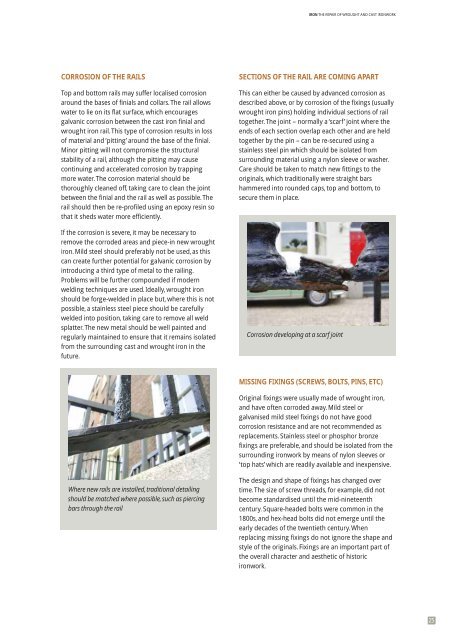The Repair of Wrought and Cast Iron Work - Dublin City Council
The Repair of Wrought and Cast Iron Work - Dublin City Council
The Repair of Wrought and Cast Iron Work - Dublin City Council
Create successful ePaper yourself
Turn your PDF publications into a flip-book with our unique Google optimized e-Paper software.
IRON THE REPAIR OF WROUGHT AND CAST IRONWORK<br />
CORROSION OF THE RAILS<br />
Top <strong>and</strong> bottom rails may suffer localised corrosion<br />
around the bases <strong>of</strong> finials <strong>and</strong> collars. <strong>The</strong> rail allows<br />
water to lie on its flat surface, which encourages<br />
galvanic corrosion between the cast iron finial <strong>and</strong><br />
wrought iron rail. This type <strong>of</strong> corrosion results in loss<br />
<strong>of</strong> material <strong>and</strong> ‘pitting’ around the base <strong>of</strong> the finial.<br />
Minor pitting will not compromise the structural<br />
stability <strong>of</strong> a rail, although the pitting may cause<br />
continuing <strong>and</strong> accelerated corrosion by trapping<br />
more water. <strong>The</strong> corrosion material should be<br />
thoroughly cleaned <strong>of</strong>f, taking care to clean the joint<br />
between the finial <strong>and</strong> the rail as well as possible. <strong>The</strong><br />
rail should then be re-pr<strong>of</strong>iled using an epoxy resin so<br />
that it sheds water more efficiently.<br />
If the corrosion is severe, it may be necessary to<br />
remove the corroded areas <strong>and</strong> piece-in new wrought<br />
iron. Mild steel should preferably not be used, as this<br />
can create further potential for galvanic corrosion by<br />
introducing a third type <strong>of</strong> metal to the railing.<br />
Problems will be further compounded if modern<br />
welding techniques are used. Ideally, wrought iron<br />
should be forge-welded in place but, where this is not<br />
possible, a stainless steel piece should be carefully<br />
welded into position, taking care to remove all weld<br />
splatter. <strong>The</strong> new metal should be well painted <strong>and</strong><br />
regularly maintained to ensure that it remains isolated<br />
from the surrounding cast <strong>and</strong> wrought iron in the<br />
future.<br />
SECTIONS OF THE RAIL ARE COMING APART<br />
This can either be caused by advanced corrosion as<br />
described above, or by corrosion <strong>of</strong> the fixings (usually<br />
wrought iron pins) holding individual sections <strong>of</strong> rail<br />
together. <strong>The</strong> joint – normally a ‘scarf’ joint where the<br />
ends <strong>of</strong> each section overlap each other <strong>and</strong> are held<br />
together by the pin – can be re-secured using a<br />
stainless steel pin which should be isolated from<br />
surrounding material using a nylon sleeve or washer.<br />
Care should be taken to match new fittings to the<br />
originals, which traditionally were straight bars<br />
hammered into rounded caps, top <strong>and</strong> bottom, to<br />
secure them in place.<br />
Corrosion developing at a scarf joint<br />
MISSING FIXINGS (SCREWS, BOLTS, PINS, ETC)<br />
Original fixings were usually made <strong>of</strong> wrought iron,<br />
<strong>and</strong> have <strong>of</strong>ten corroded away. Mild steel or<br />
galvanised mild steel fixings do not have good<br />
corrosion resistance <strong>and</strong> are not recommended as<br />
replacements. Stainless steel or phosphor bronze<br />
fixings are preferable, <strong>and</strong> should be isolated from the<br />
surrounding ironwork by means <strong>of</strong> nylon sleeves or<br />
‘top hats’ which are readily available <strong>and</strong> inexpensive.<br />
Where new rails are installed, traditional detailing<br />
should be matched where possible, such as piercing<br />
bars through the rail<br />
<strong>The</strong> design <strong>and</strong> shape <strong>of</strong> fixings has changed over<br />
time. <strong>The</strong> size <strong>of</strong> screw threads, for example, did not<br />
become st<strong>and</strong>ardised until the mid-nineteenth<br />
century. Square-headed bolts were common in the<br />
1800s, <strong>and</strong> hex-head bolts did not emerge until the<br />
early decades <strong>of</strong> the twentieth century. When<br />
replacing missing fixings do not ignore the shape <strong>and</strong><br />
style <strong>of</strong> the originals. Fixings are an important part <strong>of</strong><br />
the overall character <strong>and</strong> aesthetic <strong>of</strong> historic<br />
ironwork.<br />
25

















